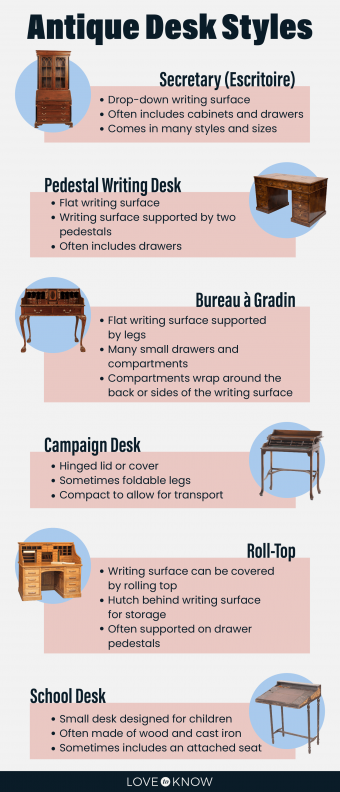
Knowing how to identify antique desk styles can help you choose the right desk for your space, as well as get a sense of the history of antique desks you own. Certain styles were popular during specific eras, which makes style an important part of dating an antique desk too.
Vintage and Antique Writing Desks
A writing desk is any desk that has a writing surface that's comfortable for writing letters or doing work that includes writing by hand. It can come in a variety of styles. You'll see antique writing desks with drawers and without, as well as those with ornate decorations or simple lines. This wide variety can make them difficult to identify, but it helps to learn a bit more about these pieces.

Types of Antique Writing Desks
One of the most famous manufacturers of antique writing desks was George Hepplewhite, but these pieces can come from a wide variety of cabinetmakers and brands. There are many types you may encounter as you shop at antique stores or auctions:
- Slant-front - An antique slant-front writing desk, which can also be a secretary desk, has a writing surface that slants up at an angle and is supported by hinges. You can fold it out for use.
- Pedestal - A pedestal desk has a writing surface supported by two pillars or sets of drawers. There's space for the user's legs between the two supports.
- Bureau à gradin - A bureau à gradin is a type of antique writing desk that has many small drawers and compartments along the back and sides of the desk surface.
Tips to Identify an Antique Writing Desk
With some careful examination, you can learn a bit about the history and age of an antique writing desk. These antique furniture identification tips will help:
- Look for a furniture mark that can tell you the manufacturer. Many antique writing desks have a label or mark on the back or underside. This can help you identify the piece.
- Examine the construction. Does it have inlays and veneer? Does it have signs of being hand-carved or planed by hand? These details can help you identify whether it was made in a factory or by hand.
- Take a look at its style. Does it fit within a certain era? It may belong to the Victorian era if it has ornate details, or it may be Mission style if it has clean lines.
Antique Secretary Desks
A secretary, also called an escritoire, is a specific type of antique writing desk that has some very practical features. It's one of the most common types of antiques desk you will encounter in antique stores or auctions. A secretary desk is a piece that has a writing surface that folds or drops down when in use. When you're done using it, the surface folds back up to save space in a room. You can find antique secretary desks in all different sizes, from small desks that fit in a corner of the room to large cabinets that have a drop-down writing surface. It's common to see them incorporated in a bookcase or china cabinet.
Types of Antique Secretary Desks
According to Collectors Weekly, the most famous manufacturer of antique secretary desks was Thomas Chippendale. However, you'll find secretary desks made by just about every furniture name. There are a few major styles of secretary desks you'll see in stores and homes:
- Drop-front - An antique drop-front secretary desk has a hinged writing surface that drops down. This describes most standard secretaries.
- Side-by-side - A side-by-side secretary has half the normal width of writing surface. It's usually part of a larger cabinet.
- Mechanical - A mechanical secretary desk includes gears that automatically flip out supports for the desk surface as it is unfolded.
- Wooten - Made by manufacturer William Wooten in the late 1800s, these secretaries open from the side like a book and include a variety of hidden compartments.
- Campaign - A campaign secretary folds up into a compact package for travel. Historically, people used these as part of wars and expeditions.
Tips to Identify an Antique Secretary Desk
The defining feature of a secretary is the way it opens, with the writing surface folding out of a piece of furniture. Here are a few other clues to help you identify an antique secretary desk:
- Look at the wood. Many secretary desks from the 1700s and 1800s feature exotic woods like rosewood, tulipwood, and kingwood. Later, cherry, maple, oak, and other hardwoods became popular.
- Examine the construction. Antique furniture hardware can help you assign a date to a piece, and a secretary nearly always has hinges. Take a good look at these to learn about its age.
- Look for a manufacturer mark or label. Often, antique secretaries will have a label affixed to the back or underside of the desk. This can help you learn more about the piece.
Other Types of Antique Desks
In addition to basic writing desks and secretaries, there are some other notable antique desk styles to consider. If you're wondering how to identify your antique desk, it may be one of these types.
Antique Roll-Top Desks
Roll-top desks are writing desks that have a top made of slats that can roll up into the back of the desk. This covers the writing surface and keeps the desk looking tidy. You'll often see these made of oak.
Antique School Desks
An antique school desk is a smaller desk that originally came from a school. These are child-sized and sometimes feature a seat attached to the front of the desk. They are usually made of wood and cast iron and are very common in antique stores.
Library Tables
Although they aren't technically considered desks, antique library tables serve the same purpose. These sturdy pieces, usually made of oak, often have pedestal legs and a desk-height writing surface.







